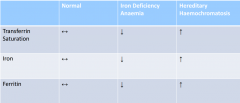![]()
![]()
![]()
Use LEFT and RIGHT arrow keys to navigate between flashcards;
Use UP and DOWN arrow keys to flip the card;
H to show hint;
A reads text to speech;
20 Cards in this Set
- Front
- Back
|
Where is most iron found in the body? |
- bone marrow and RBCs (3 of the 4 grams) |
|
|
List 4 enzymes types which contain iron |
- cytochromes - peroxidases - xanthine oxidase - catalases - RNA reductase |
|
|
Name 2 places where iron is stored |
- predominantly intracellularly in ferritin; small amount in serum ferritin - also in haemosiderin |
|
|
What transports iron in plasma? How many binding domains does it have? |
- transferrin - 2 (looks like an antibody) |
|
|
How much iron do men and woman need per day, respectively? |
- men: 1g/day - woman: 2g/day |
|
|
Name a food where you would find haem iron Name 3 foods where you would find non-haem iron |
- haem iron: red meat - non-haem iron: white meat, vegetables and cereals |
|
|
Where is iron absorbed? Which cell types are responsible for absorption? Which enzyme is needed to absorb non-haem iron (to reduce from the ferric to the ferrous form) |
- duodenum - enterocytes - cytochrome b1 |
|
|
Which "pump" needed for enterocytes to take up iron? Which 2 regulators are required for iron to be transferred from enterocytes to plasma? |
- divalent metal transporter 1 - ferroportin and hepcidin |
|
|
Where is transferrin produced? How much iron can each transferrin molecule bind? How is iron delivered to cells? Where is the 2 highest concentratons of transferrin receptors found? |
- liver - 2 (4mg) - transferrin-iron binding complex binds to the transferrin receptors on cells - red blood cell precursors and in the liver |
|
|
How would you describe the blood cells of someone with haemolytic anaemia? |
- hypochromic - small |
|
|
In order, what are the 3 most likely causes of haematinic deficiency in coeliac disease? |
- folate deficiency (most likely) - iron deficiency (2nd most likely) - b12 deficiency (unlikely) |
|
|
What is hereditary haemochromatosis (3)? |
- autoimmune recessive disorder - of iron metabolism - causing iron overload |
|
|
Which mutation is mosty common in herediatry haemochromatosis? How does this result in hereditary haemochromatosis? Which gender is more likely to be affected and why? |
- C282Y mutation in the HFE gene - reduced heptcidin production - males; menstruation and child birth is protective due to blood loss |
|
|
What is the affect of iron in the following tissues; liver pancreas skin joints |
- liver: cirhosis - pancreas: diabetes - skin: bronzing - joints: athritis |
|
|
What is the treatment and management of someone with iron overload? |
- venesection (removing 500ml of blood removes 250mg of iron) - monitir ferritin and transferrin? - prevent or limit organ damage |
|
|
Give 2 differences between ferritin and haemosiderin |
- ferritn is soluble; haemosiderin is insoluble conglomerates of ferritin - iron is readily available from ferritin; iron is only slowlu available from haemosiderin |
|
|
What is the most likely cause of Iron deficiency Anaemia is men and post menopausal women What is the most likely cause of Iron deficiency Anaemia in young women? When would you investigate a young woman if you suspected iron deficieny anaemia? |
- blood loss - menstrual blood plis or minus pregnancy - if there was blood in her stool |
|
|
What is the most imporant hormone in the regulation of iron? Where is it produced? Broadly what does it do? |
- hepcidin - liver - reduces the level of iron in plasma: binds and degrades ferroportin - reducing GI iron absorption, and reducing iron release from macrophages |
|

|

|
|
|
Name 1 condition associated with iron overload and 1 associated with depleted iron |
- iron overload: hereditary haemochromatosis - iron depletion: iron deficiency anaemia |

